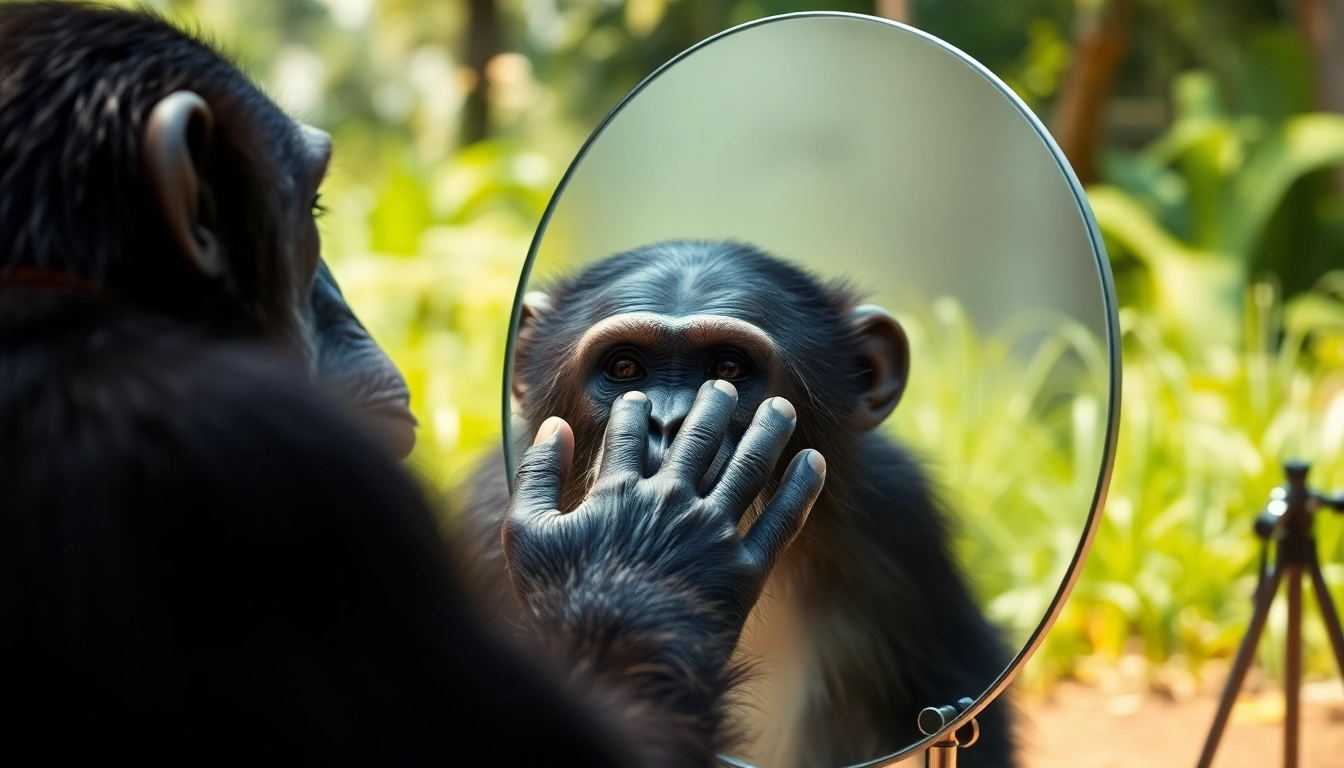What is Mirror-Testing?
Definition and History of Mirror-Testing
The mirror-testing method, also referred to as the mirror test or mark test, is an innovative behavioral technique used primarily to assess self-recognition in different species. The tool was developed in 1970 by American psychologist Gordon Gallup Jr. It involves placing a mark on an animal in a way that it cannot see without a mirror. If the animal inspects the mark while looking in the mirror, it indicates a level of self-awareness, suggesting that the creature recognizes its own reflection as itself rather than another being.
The foundations of this testing method can be traced back to philosophical inquiries into self-awareness and consciousness. Early philosophers speculated about the self’s recognition and whether other beings shared this understanding. Gallup’s formulation of the mirror test provided a scientific framework to address these debates, leading to numerous studies across various animal species including apes, dolphins, elephants, and even some birds.
Over the decades since its inception, mirror-testing has not only grown in prominence within the realm of psychology and zoology but it has also sparked debates regarding the exact parameters that signify self-awareness and the nature of consciousness itself.
How Mirror-Testing Assesses Self-Awareness
Mirror-testing aims to evaluate the cognitive level of self-awareness in animals through observed behaviors in the presence of a reflective surface. The experiment typically incorporates a colored mark applied discreetly to a place on the animal’s body, such as the forehead. When placed in front of a mirror, an animal that possesses self-awareness is likely to investigate and attempt to remove the mark, indicating recognition of its reflection and understanding that the image it sees is itself.
Traditional interpretations posit that only a few advanced species pass this test, suggesting a threshold of cognitive complexity and self-awareness. However, the parameters of the test have faced scrutiny, leading researchers to consider that different species might possess various forms of self-awareness not fully encapsulated by the test.
Applications of Mirror-Testing in Behavioral Studies
The applications of the mirror test extend from basic research into animal cognition to assessing the developmental stages of humans. In children, for example, the mirror test serves as a barometer for assessing cognitive milestones. Early child psychologists use adaptations of the mirror test to gauge self-recognition in toddlers, typically around the age of 18 months to 2 years when significant cognitive growth occurs.
Furthermore, mirror-testing has observed cross-species comparisons that reveal similarities and contrasts in self-recognition abilities. This has implications not just in understanding animal cognition but also in enriching fields such as animal welfare, conservation strategies, and studies into the evolution of consciousness.
Types of Mirror-Testing Techniques
Traditional Mark Test Method
The Traditional Mark Test is the most recognized form of the mirror test. The general procedure is simple yet effective: apply a visible mark to an animal’s body, then place it before a mirror and observe its reactions. Notably, species such as great apes, elephants, and magpies are among those that have successfully completed this test. Their capacity to recognize themselves suggests a degree of cognitive sophistication that allows for considerations of self within their environment.
In testing scenarios, the responses can vary; some animals may display curiosity, while others may instinctively react to their reflection without understanding it. Observers note these interactions closely to interpret perceived levels of self-awareness among different species.
Modified Approaches in Different Species
As mirror-testing spread in scientific inquiry, researchers developed modified approaches catering specifically to various species. For instance, some birds such as the Asian elephant exhibit differing reactions depending on their visual and environmental contexts, leading to adaptations of the testing procedures.
In the case of birds, researchers may employ different colors for the marking or utilize video footage projected on a mirror to accommodate their visual capacities. Such methodologies underscore the importance of tailoring research techniques to the individuals being examined, ensuring accurate assessment of self-recognition.
Innovative Technologies in Mirror-Testing
With advancements in technology, innovative imaging techniques such as the use of video playback have emerged. By combining mirror-testing with digital technology, researchers can capture and analyze behavioral responses more accurately. This enables more extensive data collection concerning interactions with reflections, providing broader insights into cognitive function and self-awareness in various species.
These advancements allow for larger sample sizes and the collection of quantifiable data, thus enhancing statistical understandings of cognitive behavior across species.
Diving Deeper: The Psychology Behind Mirror-Testing
Understanding Self-Recognition in Animals
Self-recognition is a complex psychological phenomenon indicating not only awareness but also social cognition and emotional intelligence. The ability to recognize oneself in a reflective surface suggests an advanced level of mental processing, indicating that these animals can conceptually separate their identity from others.
Studies have provided evidence suggesting a link between self-recognition abilities and other cognitive skills within the animal kingdom. The presence of self-awareness can correlate with problem-solving abilities, social intricacies, and adaptation strategies in animals, highlighting the evolutionary benefits of such cognitive advancements.
Implications for Human Psychological Development
The implications of mirror-testing are profound for understanding human psychological development. Through mirror-testing, psychologists assess the stages at which infants begin to recognize themselves as separate entities from others, thereby facilitating an understanding of identity development. This self-recognition process is fundamental to the emergence of empathy and complex social interactions later in life.
Early childhood studies often correlate the passage of the mirror test with milestones in language and emotional development, suggesting a deeper layer of interconnectedness between self-awareness and overall cognitive growth.
Comparative Analysis of Species Performance in Mirror-Testing
A comparative analysis of species performance in mirror-testing reveals stark contrasts in cognitive evolution. For instance, while great apes often show high levels of self-recognition in traditional settings, other intelligent species like certain cetaceans may exhibit different forms of cognition.
Studies highlight that while some animals may not pass the mirror test, they may demonstrate sophisticated understanding in other areas, such as tool use or environmental manipulation. This comparative approach expands the boundaries of cognitive assessment, urging future researchers to develop more inclusive methodologies that consider the diverse intelligence spectrums present in the animal kingdom.
Common Challenges in Mirror-Testing
Variations in Animal Responses
While mirror-testing provides valuable insights, interpretations of results can be complicated by variations in animal responses. Differentiating between curiosity and recognition can prove challenging, as many animals rely on visual cues from their surroundings and live in environments where mirrors are not a natural element.
Additionally, some species that do not pass the mirror test may utilize alternative sensory modalities, highlighting the necessity of considering context when interpreting results. Researchers must account for these variances to draw accurate conclusions from testing.
Factors Affecting Mirror-Testing Results
Several factors can affect mirror-testing results beyond just the animal’s cognitive capacity. Environmental factors, such as the visibility and placement of the mirror or the characteristics of the mark used, can influence outcomes. Some animals may be deterred by the reflective surface itself, while others may not have the visual acuity to recognize the mark.
Researchers must ensure standardization in testing environments to mitigate these influences, thereby enhancing the reliability of results and ensuring valid assessments across species.
Ethical Considerations in Mirror-Testing Research
The ethical implications surrounding mirror-testing raise concern among the research community. As the quest to evaluate self-awareness progresses, researchers are tasked with conducting studies respectfully and within the ethical bounds of animal welfare.
Critics emphasize the importance of considering the subjective experiences of animals during testing procedures. Enhancing standards for humane treatment in psychological experiments is essential, ensuring that research serves meaningful contributions to both science and conservation.
Future Horizons in Mirror-Testing Research
Potential Advances in Mirror-Testing Methodologies
The future of mirror-testing encompasses potential advances in methodologies and technologies that diversify and enrich examinations of self-awareness. Innovations in virtual reality could provide a new dimension to mirror-testing by simulating reflective interactions and observing responses.
Embracing interdisciplinary research that unites psychology, technology, and neuroscience may yield fresh perspectives on cognitive assessment, leading to better grasp of the underlying processes of self-awareness.
Exploratory Studies in New Animal Species
Future endeavors within the realm of mirror-testing could delve into the uncharted territories of previously unexamined animal species. As an understanding grows, researchers aim to unpack the cognitive complexities of lesser-studied or novel species, expanding our grasp of self-recognition and intelligence across the biosphere.
Exploring the cognitive attributes present in varied environments introduces an opportunity to reevaluate prior assumptions concerning sentience and consciousness in members of the animal kingdom.
Impact of Mirror-Testing on Understanding Consciousness
Ultimately, advancements in mirror-testing research hold the power to reshape concepts of consciousness both within animals and across humans. As scientists continue to expand methodologies, challenging foundational ideas about what constitutes self-awareness can yield deeper insights into the evolutionary agility of cognition.
This ongoing journey enhances our appreciation for the cognitive landscapes of non-human species while sparking philosophical discourse on the nature of consciousness itself. The quest to understand consciousness remains intrinsically linked to mirror-testing and the intricate evolution of self-awareness across life on Earth.




